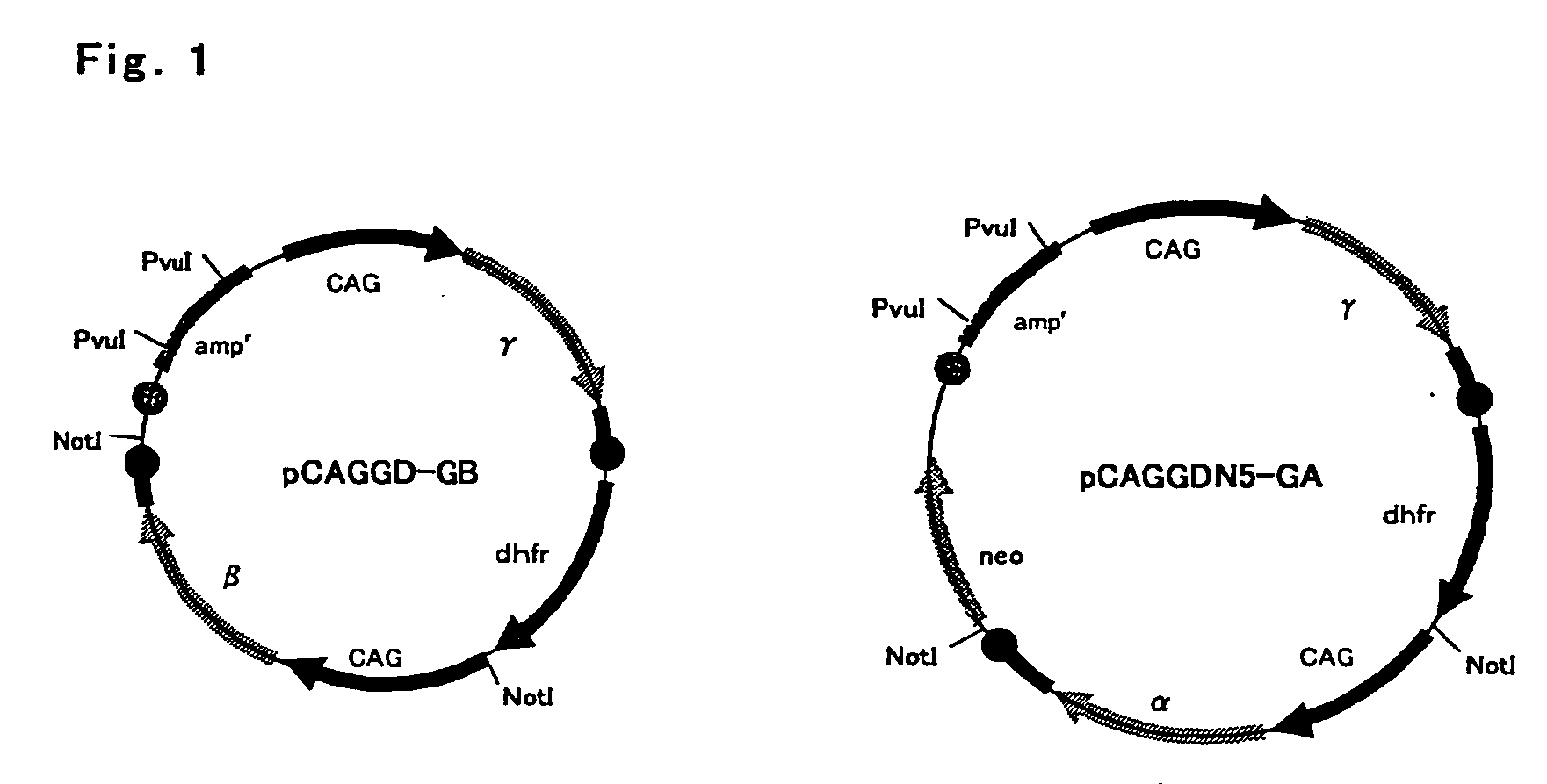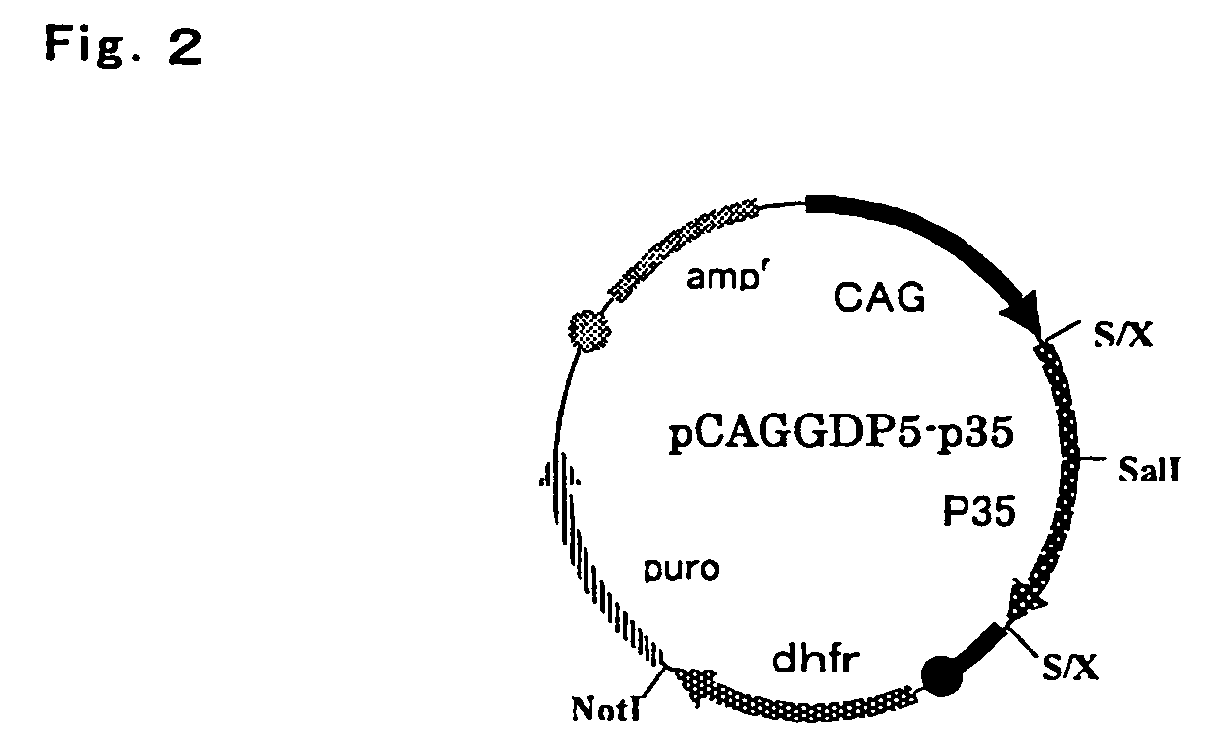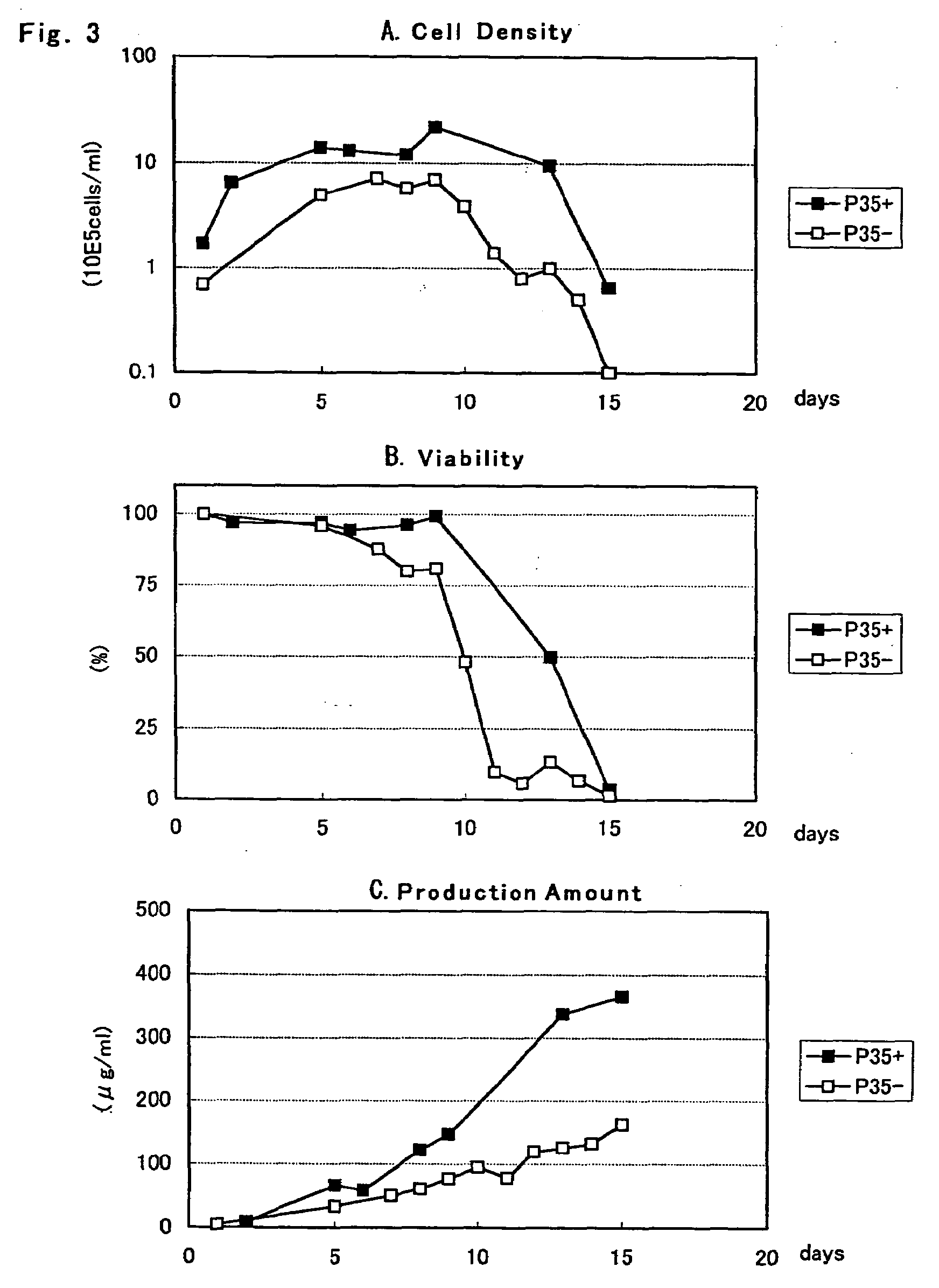Novel Protein Highly Producing Recombinant Animal Cell, Method for Preparing the Same, and Method for Mass-Producing Protein Using the Same
a recombinant animal cell, high-producer technology, applied in the direction of peptides, genetically modified cells, fibrinogens, etc., can solve the problems of increasing cell density, effective solving strategy has not been found, etc., to prolong viability, increase the protein production ability of recombinant animal cells, and reduce the effect of viability
- Summary
- Abstract
- Description
- Claims
- Application Information
AI Technical Summary
Benefits of technology
Problems solved by technology
Method used
Image
Examples
example 1
Isolation Of Fibrinogen Gene
[0072]For a human fibrinogen gene, Human Liver Marathon-Ready cDNA (BD Bioscience) was used as a template, each two of Kozak sequences and those sequences with a necessary enzyme site added thereto for an α chain, a β chain and a γ chain were prepared as a primer (SEQ ID NOS: 1 to 6), and a PCR reaction was performed using Advantage HF-2 PCR Kit (BD Bioscience) according to a protocol of the kit. As a result, a band of PCR amplification was detected in each of the α chain, the β chain and the γ chain. Since sizes were consistent with the known sizes of α chain, β chain and γ chain, cDNA genes, these genes were cloned (pFbgA, pFbgB and pFbgG, respectively) using a TA cloning kit (Invitrogen), and nucleotide sequences thereof were determined using ABI PRISM310 Genetic Analyzer (PE Biosystems). As a result, FbgA, FbgB and FbgG genes which are shown in SEQ ID NOS: 7 to 9, respectively, were obtained.
example 2
Construction Of Fibrinogen Gene Expression Vector
[0073]Fibrinogen β chain and γ chain gene expression vector pCAGGD-GB, and fibrinogen α chain and γ chain gene expression vector pCAGGDN5-GA used in this example were constructed as follows. For pCAGGD-GB, first, pCAGG-S1 dhfr (WO 03 / 004641) was digested with BamHI, end-blunted with a T4 DNA polymerase, and ligated using a phosphorylation NotI linker (Takara Shuzo) to construct pCAGG-S1 dhfrN, and a SalI fragment of an FbgG gene derived from pFbgG was incorporated into a SalI site thereof to construct pCAFFD-G. Further, pCAGG (Xho) (WO 03 / 004641) was digested with SalI, end-blunted with a T4 DNA polymerase, and ligated using the phosphorylation NotI linker (Takara Shuzo) to construct pCAGG (Xho)N, a XbaI-BamHI fragment containing SalI of pCAGG-S1 (WO 03 / 004641) was incorporated into a XbaI-BamHI site of this plasmid, a BamHI site of the resulting plasmid was digested, end-blunted with a T4 DNA polymerase, and ligated using the phospho...
example 3
Preparation Of Recombinant Fibrinogen Expressing Cell: Introduction Of Cell Into Expression Vector, Gene Amplification, Cloning
[0075]According to a method which will be described below using the fibrinogen expression plasmids pCAGGD-GB and pCAGGDN5-GA constructed in Example 2, a CHO DG44 (Urlaub G et al., Somatic cell. Mol. Genet., 12, 555 (1986), hereinafter CHO) cell was transformed. On the day before transformation, a CHO cell was seeded on a 6 well plate at a cell density of 1 to 0.5×105 cells / 2 ml / well using a YMM medium (nucleic acid-free MEM alpha medium enriched in amino acid-vitamin containing insulin, transferring, ethanolamine and sodium selenite) containing 10% bovine fetal serum (FCS, manufactured by GIBCO-BRL). After cultured at 37° C. overnight in a 5% CO2 culturing apparatus, using a liposome transformation reagent, TransIT-LT1 (Takara Shuzo) or lipofectamine 2000 (Invitrogen), each equal amount of fibrinogen expression plasmids pCAGGD-GB and pCAGGDN5-GA were mixed, ...
PUM
| Property | Measurement | Unit |
|---|---|---|
| concentration | aaaaa | aaaaa |
| pH | aaaaa | aaaaa |
| pH | aaaaa | aaaaa |
Abstract
Description
Claims
Application Information
 Login to View More
Login to View More - R&D
- Intellectual Property
- Life Sciences
- Materials
- Tech Scout
- Unparalleled Data Quality
- Higher Quality Content
- 60% Fewer Hallucinations
Browse by: Latest US Patents, China's latest patents, Technical Efficacy Thesaurus, Application Domain, Technology Topic, Popular Technical Reports.
© 2025 PatSnap. All rights reserved.Legal|Privacy policy|Modern Slavery Act Transparency Statement|Sitemap|About US| Contact US: help@patsnap.com



